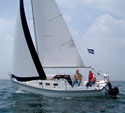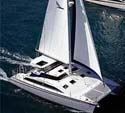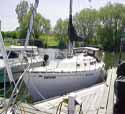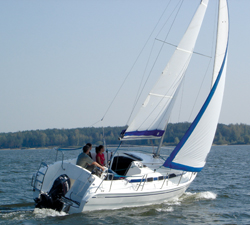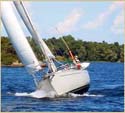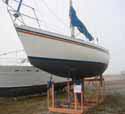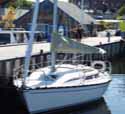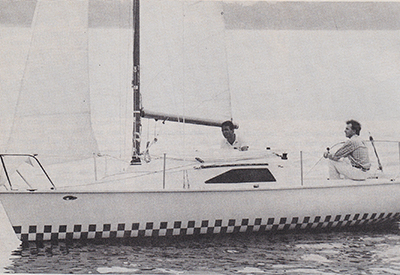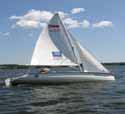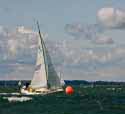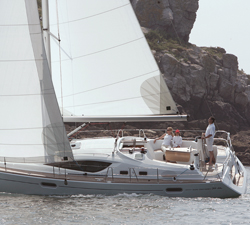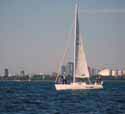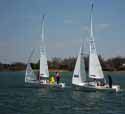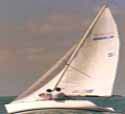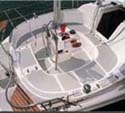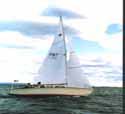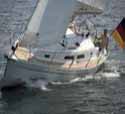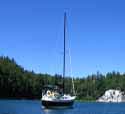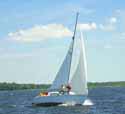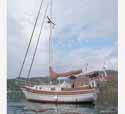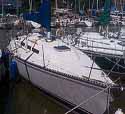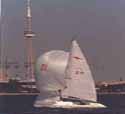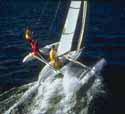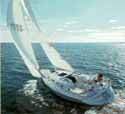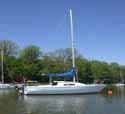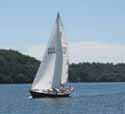November 14, 2009
Sunfast 3200
It’s really all about sailing! Designed by France’s Daniel Andrieu, the Sunfast 3200 certainly is a head turner. This experienced and well-accomplished designer has won the hearts of many for this wide hulled 9.8 meter boat lofted to address the racing and performance cruising market. It’s perfect for single handling or racing with a team.
November 2, 2009
Precision 23
As a trailer boat sailor – one of life’s guilty pleasures is casting off from the dock early in the season, against the backdrop of the busy boatyard – heading out to sail while those left on land await the arrival of the crane – “a couple of weeks from now”. So while the boat yard in Port Dover Ontario bustled with the pre-season rituals of washing, waxing, sanding, painting and resealing – we set off to test sail the Precision 23, a friendly uncomplicated and seaworthy performer.
November 2, 2009
PDQ 36
PDQ Yachts was founded in 1987, when the present malaise of the Canadian pleasure boat building industry was gaining momentum. Nonetheless, the optimistic PDQ team were determined to bring into production a “modern, commodious, performance catamaran of impeccable quality.” All principles are keen sailors and multi-hull enthusiasts. They include president and director Harvey Griggs, an engineer with a doctorate degree from Massachusetts Institute of Technology; Alan Slater, a manufacturing consultant who has been designing one-of catamarans for 20 years; and vice-president Simon Slater, with ten years prior experience in the marine industry. They are backed by a board of directors with experience in law, finance, accounting, technology, manufacturing and marketing.
November 2, 2009
PDQ 32
Boatbuilder Simon Slater and his designer-father, Alan, are making a significant impact on the multihull industry. In fact, the Canadian boatbuilding industry is noticing a substantial contribution from multihulls that wouldn’t even have Been considered possible 15 years ago. Last month I toured through the PDQ plant and was treated to a sight I haven’t seen in Canada for quite a while-a real production line firing boats out the door to waiting customers! Not only were all the PDQ 32s (and their big sisters, the 36s) sold, but the shop is booked solid for the next six months.
November 2, 2009
Ontario 32
Oakville’s Ontario Yachts was founded by Dick and Maria Kneulman. Although he worked as a boat builder before emigrating from the Netherlands in 1951, Kneulman started a construction company when he first moved to Canada. But by 1961 Dick was building boats-mostly kayaks and dinghies. After only a few years in the business, Ontario Yachts established a reputation for high-quality workmanship and soon Kneulman’s Snipes were sought after by North America’s top one-design racing sailors. Next, Dick established a world-wide market for his dinghy, 6 Metre and Dragon masts.
November 2, 2009
Odin 820
There are many reviews for the Odin 820, a 28’ motor sailor that includes the comparisons to others like her in the market place. This is not one of them. All that good stuff can be found on the website www.odin-marine.com. Me, I’m a traditional keel boater. I love getting a thoroughbred boat well-tuned with the rail down, going as fast as we can with all the excitement of pushing the boat to her limits. Seeing the water creaming down the hull of a go fast sailboat gives me as much of a thrill at 60 as it did at 20.
November 2, 2009
Nonsuch 30
Nonsuch, as reported by Brian Shelley, means “without rival” (Without Rival, by Brian Shelley and Mary Beaucock Fryer, 1995. Wishbone Publishing Co. Willowdale). The class was named after the Nonsuch of the Hudson’s Bay Company that first sailed in 1968. That vessel was named after Baroness Nonsuch of Nonsuch Park, Surrey, England, who was the mother of King Charles II’s two natural sons. The Baroness also bore the illegitimate daughter of John Churchill, who was the First Duke of Malborough, and became governor of the Hudson’s Bay company in 1685.
November 2, 2009
Niagara 35
The Niagara 35 is neither traditional cruiser (the fin keel and spade rudder are modern), nor modern racer/cruiser (the fin keel and spade rudder are too traditional). Indeed, it notable sheer further confuses the matter. The Niagara’s high topsides compare to contemporary designs but its coach house hints at the traditional shapes and trim of older designs.
November 2, 2009
Sirius 28
If the Sirius 28 was a racehorse, it would be described as having good breeding. Its designer, Hubert Van de stadt, has in his stable the smaller Sirius 22, a restyling of his Sirius 21, which has proven to be a tough, able, small cruiser. This talent for design runs in the family. Hubert is the nephew of the well-known European designer E. G. Van de Stadt, who has a long and impressive list of outstanding designs, including the lines of the famous 72-foot South African ketch Stormvogel. The Sirius 28’s builders also inspire confidence. Vandestadt and McGruer Ltd. of Owen Sound ahs been building boats since the mid-’60s and in spite of such setbacks as major fire and a long industry recession, it has managed to survive and grow…
November 2, 2009
Nelson Marek 36
Built initially by Martin Yachts in Vancouver for IMS (International Measurement System) and ultimately for one design racing, the Nelson/Marek 36 is a design with focus. Until a fleet is established, however, racing under the IMS rule will have to be endured, as the real goal is to race identical boat against identical boat to test the talents of skippers and crews.
November 2, 2009
Mirage 275
It was right in the middle of hot, muggy weather in July when we would have given anything (except our air conditioners) to be out on the water. We had been riding a seesaw with the weather all week waiting for the perfect time to test the new Mirage 275 in Whitby, Ontario.
November 2, 2009
Mirage 26/27
Love and Anarchy, Mirage 26 hull #51, was launched June 3, 1978 for a new sailor, Diane Wait, who had previously sailed “two or three times with friends.” “I went to the Toronto International Boat Show to find a boat I could handle,” remembers Wait. “I also wanted a boat I would be content to sail indefinitely. I didn’t want to be looking to trade up for something two feet longer in a few years.” She went to the show three times that year, looking at boats in this size range over and over again. On the third visit she left a deposit on the Mirage 26.
November 2, 2009
Mirage 25
It is difficult indeed to find a boat under 27 or 28 feet in length that provides civilized cruising comfort for two to four people. We are happy to report that the Mirage 25 is a surprising and successful example of a “livable” boat with an overall length (excluding the bow pulpit and outboard rudder) a few inches over 25 feet. Up to four adults could cheerfully weekend aboard, and with a few minor modifications a couple could cruise comfortably for indefinite periods.
November 2, 2009
Martin 242
There is something about the look of the Martin 242 that makes it stand out in the gaggle of 24-footers you find in most marinas today. It’s difficult for it to hide. The tall fractional rig, with its huge main, is a dead giveaway. This is not your ordinary weekender. There is something about its knuckled forefront and wide, slightly racked transom that suggests speed and power.
November 2, 2009
Tanzer 22
Quebec’s Tanzer Industries Ltd. launched the first Johann Tanzer-designed Tanzer 22 in 1970. The launch was well-timed, for the ensuing decade brought unprecedented growth to the sport of sailing. This small sailboat surfed into the leaders of the fleet of vessels in this size range which builders turned out in great numbers to satisfy the demand for introductory ballasted boats. Most of the 2,270 units built were constructed in Dorion, Que. The boat was also produced in Edenton., N.C., (270 units) and in Arlington, Wa. (167 units). Offered in fin keel and keel centreboard configurations, only about 200 centreboards were built as they were not competitive in racing fleets. In 1985 Tanzer gave the Tanzer 22 a “facelift”…
November 2, 2009
Martin 16
“Since my accident sailing was a very distant thought and only provided me with many great memories as I was lying in my bed at the hospital. Being on the water again was one of the most exciting things that has happened to me since my accident.” This is a quote from CY test-pilot Danny McCoy at the helm of the Martin 16, a sport-boat for sailors with mobility impairments.
November 2, 2009
Kirby 25
Skipper Jim Matthew is nice enough on land. He smiles, issues pleasantries with an English accent and talks about racing. On the water his whimsical Kirby 25 appears with big red lips on a white spinnaker. But don’t be fooled. The name of the boat is Poch Ma Hon, Gaelic for “kiss my ass.” And the sight of this boat frays the nerves of other Kirby sailors from the Barrie Yacht Club in Barrie, Ontario.
November 2, 2009
Jeanneau 39DS
Canadian Yachting has done a lot of reviews of European boats of late but because of timing we have missed the Jeanneau boat line and have yet to review it. The builder is well-known and well-established and has been building boats for over 50 years. The line is well represented in Canada with Ontario-based Angus Yachts, Quebec’s Marina Gagnon and Fraser Yachts in BC.
November 2, 2009
J 22
We opened our 1984 Lake Ontario sailing season in early April with a test ride on a J/22 the new, small planning keelboat from J Boats, Inc. of Newport, RI. We discovered a fun, spritely yacht packed with performance. Launched in the United States for the 1983 season, the J/22 has been an instant success, with more than 360 boats sold south of the border in less than a year.
November 2, 2009
Ideal 18
Canada’s Conneticuit-based yacht designer Bruce Kirby has long been known for the singlehanded Laser. Of course, he has designed numerous boats in the two decades that have passed since the famous dinghy made its debut, and one of the most recent is the Ideal 18. Although this new design is a keelboat, with a crew of two, the basic philosophy behind it is true to the little boat that made Kirby a household name — in nautical households.
November 2, 2009
Hunter 336
Have you dreamt of shutting down your office computer, casting off your docklines and cruising to a sunny southern sea? Hunter Marine’s skipper Warren Luhrs had a similar dream and left his successful boat building business in the mid-’80s to indulge in his passion for offshore racing. But as Luhrs zipped around Cape Horn on Hunter’s Child during his record-breaking 80-day sail from New York to San Francisco in 1988, the good-ship Hunter Marine began to flounder in deep water.
November 2, 2009
Thunderbird
Myth: Thunderbirds are wood. Reality: Thunderbirds are built in both wood and fibreglass. Myth: Plywood is a pain.Reality: Yes it is, but if you’ve got the time it’s a great way to save money. More second hand Thunderbirds would probably be purchased if there were more used fibreglass Thunderbirds on the market. While the used plywood Thunderbirds out there represent incredible value in terms of boat-for-the-buck, dealing with the joys of wood are not for everyone. So we will take a three-step approach to analyzing the definitive affordable boat; we’ll look at design considerations, wood boats and fibreglass boats. A design sponsored by the forestry industry. The Thunderbird embodies family sailing. Its origins are in a competition sponsored by…
November 2, 2009
Hunter 29.5
When I select boats for my column each issue, I try to gather those which have a distinctly Canadian flavour, either in design, construction or ownership. Even though the Canadian content of the new Hunter 29.5 could be considered small, I have to admit a personal interest—the head of the design team is fellow Canadian, good friend (and occasional CY contributor) Rob Mazza.
November 2, 2009
Hanse 315
It was a perfect day for boat testing and not so great for picture taking, but we always like the chance to go sailing when we can demonstrate to ourselves the full attributes of any boat. They say the devil is in the details and the Hanse 315 did not disappoint. The 315 is the smallest in the new generation of the Hanse line and Hanse continues to impress setting trends and showing great innovativeness.
November 2, 2009
Halman 21
One of the first boats I considered buying during my search for the perfect “”starter”” many sailing years ago was the traditional “”North Sea Double-Ender,”” a design similar to the Halman 21. To me, it possessed the quintessential qualities necessary for the perfect offshore vessel – transom-hung steering, long keel, curving sheer, an almost plumb entry, and powerfully built.
November 2, 2009
Grampian 26
It was one of the nicest sails I have had in my home waters. The sun was shining and the wind was easterly at Trade Wind strength, force 3 to 4. We motored out the opening in the breakwall near Toronto’s Western Gap and set the mainsail and the roller-furling genoa in the lee of Ontario Place. Then we close-reached for an hour into Lake Ontario at a steady six knots.
November 2, 2009
Gozzard 36
The H.T. Gozzard 36 bears no resemblance to the old-fashioned cutters, with their widow-maker bowsprits and running backstays. There are no running backstays in sight, and her bowsprit is a nice, wide platform that conveniently stows the anchor and provides a wonderful spot for dolphin watching.
November 2, 2009
Express 35
The Express 35 represents an impressive blend of sailing performance and elegant cruising comfort. There is sufficient room in its overall length for a posh interior without compromising the appearance or the sailing ability of the hull shape. The abundance of carefully fitted stowage units and many other thoughtful details all contribute to making the 35 a yacht an owner can be justly proud of.
November 2, 2009
Express 30
The Express 30 was designed by Steve Killing as a “30-foot boat that would have performance, comfort and grace”. Not unexpectedly, the Express 30 has a keen emphasis on performance, and its uncluttered interior accented with the warmth of oiled teak does indeed provide a clean, functional air of comfort and grace.
November 2, 2009
Electra Sport 20
What do you get when you cross an Ideal 18 with a 505…? After two action-packed test-drives on Lake Ontario last summer, my answer is speed, excitement, convenience – and the new Electra Sport 20. Hot of the drawing board of the design team of sailmakers Hubert Raudaschl of St. Wolfgang, Austria, and Heider Funck of Toronto, this sleek sport-boat made its Canadian debut as it screamed around the race course in Toronto’s Humber Bay this past summer. Four years ago, Funck began to dream about building a small performance-oriented, One-Design keelboat that would be fast, easy-to-handle and also simple to pack up at the end of a day’s racing.
November 2, 2009
Dragonfly
If you have been a faithful reader of Canadian Yachting, this boat will not appear new to you. I reviewed it in June, 1989, and Paul Howard sailed it across our pages in a performance review in January, 1990. Since my review, over 50 boats have been built. The reason the Dragonfly returns to CY is a very significant design change.
November 2, 2009
Ticon 30
The Ticon T-30 is a roomy, comfortable boat — surprisingly big for a 30-footer. With 9,600 lbs. of displacement, 11 feet of beam and relatively high topsides, the T-30 can be characterized as “beefy,” compared to other boats from 29 to 30 feet. This interior layout makes effective use of the greater than average space and includes some intriguing and different design features. Although we were slightly disappointed with the finishing details of this yacht in a number of minor areas, overall we judged the T-30 to offer solid sailing performance without sacrificing the comforts of a home away from home. The T-30 was designed by Halsey Herreshoff in 1979 for Texas Marine Industries, an American Company that built 48 T-30s between 1979 and 1981…
November 2, 2009
Shark
When George Hinterhoeller designed the Shark in 1959, he was looking for a boat that would “go like hell when the wind blew”. Growing up in Austria’s Salzkammergut region, Hinterhoeller was used to light displacement fin-keelers: fast, responsive and exciting. The few sailboats he found on Lake Ontario when he emigrated to Canada in 1952 had heavy displacement hulls. They were ponderous and had a bad habit of hobby-horsing in the rough Lake Ontario chop. This young builder/designer was also bored by their performance. Announcing that he could build a boat that would sail circles around the rest, he retired to the shed behind his Niagara-on-the-Lake home and built Teeter Totter, a hard-chined 22-foot sloop made of plywood…
October 29, 2009
CS 36 Merlin
It has been more than 10 years since the CS 36 Merlin was first introduced in the boating market, but despite its age, this design is still one of the most popular boats in its class. With the CS 36 Merlin, CS Yachts became one of the first builders to bring the euro-style of yacht design to North America. Large aft cabins and aft cockpits provided good carrying capacity, and a generous beam all the way back to the stern kept the helm spacious and created truly usable swim platforms. The new plumb bows extended waterlines and created better value per foot. All of these changes proved positive for CS, and remain popular with many boat builders and buyers even today.
October 29, 2009
CS 34
At Toronto’s Dockside in-water boat show September 1989, CS Yachts unveiled its new 34 – so new that it didn’t even have an interior. The new Tony Castro design had first been put into production by MG Yachts in England, and CS had yet to sort out its own accommodations plan and detailing. Nonetheless, consumer reaction was positive. Fueled by an innovative marketing concept (introductory price under 90 G’s) and some interesting features, the design gained an instant following: ready buyers. (Nothing succeeds like price point.) “We wanted,” said newly installed marketing manager Stuart Robertson “a ‘show stopper’ to introduce what we believe is the only quality 34-footer in today’s market at an affordable price. Our strategy was to target second-time owners and at the same time pitch first-time buyers with a true-value bargain. “The strategy appears to have worked and Robertson was happy to display affidavits from satisfied owners championing the qualities of the new yacht, above and below the waterline.
October 29, 2009
CS 27
Are you searching for a second-hand boat for under $20,000, with a diesel inboard, a comfortable interior, standing headroom and good club-racing performance? In my opinion, there are few well-known production boats that meet this description. The Mirage 26/27, for example, has a gas OMC Saildrive inboard; the C&C 27 has the Atomic IV (also gasoline) inboard. And although the Bayfield 25 has an inboard diesel, it falls short on headroom and club performance. Camper and Nicholsons’ design The Cs 27, designed in 1975 by Raymond Wall, is a boat that fits this bill perfectly. Wall, from the respected British design house of Camper and Nicholsons, drew the lines of three cruiser/racers – for CS Yachts Ltd. in Brampton, ON. The first of Wall’s boats for Canadian Sailcraft, the design brief of the 27 called for a family cruiser, with racing performance under the International Offshore Rule (IOR).
October 29, 2009
CS 22
A couple I knew were in the market for a 22 to 24 footer. They had been avid dinghy sailors, but with two children, six and three years of age, they wanted to switch to sailing a ballasted boat. “We can afford $7,000 to $8,000, and a trailerable boat would help keep annual costs down,” they advised me. I recommended the CS 22 without reservation for both monetary value and sailing enjoyment. I had crewed on a CS 22 in club races during the early ’80s, and knew the design as a comfortable and stable boat with surprisingly good performance. The sails are relatively small, and even spinnaker handling is no big chore. Reef early, keep her sailing flat, and the boat remains dry and comfortable in rough weather. Designed by John Butler of the U.K., this was the first boat for many Canadian sailors during the rapid growth of the sport in the 1970s. More than 500 were built by Canadian Sailcraft (now CS Yachts of Brampton, Ont.) between 1971 and 1976, before production was halted as the builder concentrated on larger models.
October 29, 2009
Corvette
"She was a good little boat from day one," said George Cuthbertson of the Corvette, which he designed back in 1965. In those pre-IOR days, boats designed to the Cruising Club of America (CCA) rule were in vogue. The rule favoured heavy displacement and shoal draft, and produced family cruisers that were also adept on the race course. Ian Morch, owner of the Belleville Marine Yard, wanted to build a boat with shoal draft which would be in demand in the Bay of Quinte, and perhaps further a field in Montreal and Chesapeake Bay. He commissioned Cuthbertson and Cassian (C&C) Limited to come up with a suitable design.


